Addition and Multiplication Rules of Probability
Addition Rule of Probability
Suppose we throw a dice. What is the probability of an old number or a prime number coming up on the dice?
If A is the event of getting an odd number and B is the event of getting a prime number,
Then, Outcomes for A = 3 {1, 3, 5}
Outcomes for B = 3 {2, 3, 5}
A∪B = A or B = getting an odd number or a prime number = {1, 2, 3, 5}
A∩B = A and B = getting an odd prime number = {3, 5}

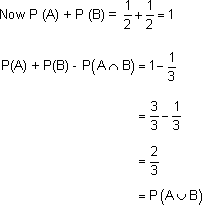
Thus P (A ∪ B) = P (A) + P (B) – P(A ∩ B)
This result is called the Addition Rule of Probability.
If however the events are mutually exclusive then P(A∩B)= 0
and P(A∪B) = P(A) + P(B)
Multiplication rule of probability
Suppose a coin is tossed twice.
Let A be the event of 'getting a head in the first toss’
B the event of 'getting a tail in the 2nd toss'
Sample space = {HH, HT, TH, TT} = 4 = Total number of outcomes
A = {HH, HT} = 2 B = {HT, TT} = 2
(A∩B) = {HT} =1

The above events are independent events. If the events are dependent then
P (A∩B) # P (A) * P (B)
Example : 22
Two dice are tossed, if E is the event of 'getting the sum of the numbers on the dice as 11' and F is the event 'getting a number other than 5 on the first dice’, find P (E∩F). Are E and F independent events?
Solution:
When two dice are cast the total number of outcomes = 6 * 6 = 36
Sample space S = |
{(1,1), |
(1,2), |
(1,3), |
(1,4), |
(1,5), |
(1,6) |
|
(2,1), |
(2,2), |
(2,3), |
(2,4), |
(2,5), |
(2,6) |
(3,1), |
(3,2), |
(3,3), |
(3,4), |
(3,5), |
(3,6) |
(4,1), |
(4,2), |
(4,3), |
(4,4), |
(4,5), |
(4,6) |
(5,1), |
(5,2), |
(5,3), |
(5,4), |
(5,5), |
(5,6) |
(6,1), |
(6,2), |
(6,3), |
(6,4), |
(6,5), |
(6,6)} |
Number of outcomes favorable to E = 2 {(5, 6) (6, 5)}
Number of outcomes favorable to F = 30
Since we exclude the set {(5, 1), (5, 2), (5, 3), (5, 4), (5, 5), (5, 6)}
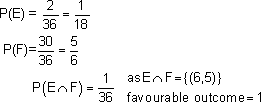

Thus, E and F are dependent events
In the above problem the pairs (1, 1) (2, 2) (3, 3) (4, 4) (5, 5) (6, 6) are called doublets.
Try these problems
A card is drawn at random from a well shuffled deck of cards. Find the probability that the card is a
a. King or a red card
b. Club or a diamond
c. Neither a heart nor a king
Answer:
Total number of outcomes = Total number of cards
n(S) = 52
- Let A = event of getting a king
n(A) = 4

Let B = event of getting a red card
n(B) = 26

Since there are 2 red kings (one of hearts and one of diamonds)
 =2
=2

By the addition theorem of probability.
Since A and B are not mutually exclusive events
 P(A or B) = P(A ∪ B) = P(A) + P(B) -
P(A or B) = P(A ∪ B) = P(A) + P(B) -
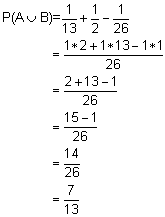
 Probability of getting a king or a red card is
Probability of getting a king or a red card is
- Let C = event of getting a club
n(C) = 13

D = event of getting a diamond
n(D) = 13

Since getting a club or a diamond are mutually exclusive events
P(C or D) = P(C ∪ D) = P(C) +P(D)
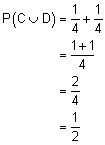
 Probability of getting a club or a diamond is
Probability of getting a club or a diamond is
- Let H = event of the card being a heart
n(H) = 13

K = event of the card being a king
n(K) = 4

 n = 1 since there is a king of hearts
n = 1 since there is a king of hearts

Probability of a card being a heart or a king
by the addition theorem of probability
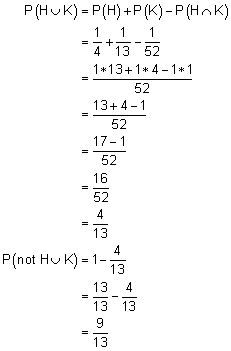
Probability that a card is neither a heart nor a king is 